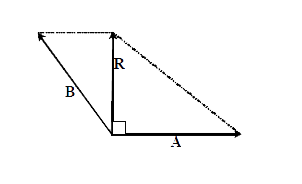Resultant of two vectors of magnitudes P and Q is of magnitude 'Q'. If the magnitude of →Q is doubled now the angle made by new resultant with →P is
30∘
90∘
60∘
120∘
The correct Answer is:B
To solve the problem step by step, we need to analyze the situation with the vectors involved.
Step 1: Understand the Given Information
We have two vectors, →P and →Q. The resultant of these two vectors is equal to the magnitude of →Q. This can be expressed mathematically as:
R=Q
Step 2: Use the Resultant Formula
The formula for the resultant R of two vectors →P and →Q is given by:
R2=P2+Q2+2PQcosα
where α is the angle between →P and →Q.
Since we know that R=Q, we can substitute this into the equation:
Q2=P2+Q2+2PQcosα
Step 3: Simplify the Equation
By rearranging the equation, we can eliminate Q2 from both sides:
0=P2+2PQcosα
This simplifies to:
P2=−2PQcosα
Step 4: Solve for cosα
From the equation P2=−2PQcosα, we can isolate cosα:
cosα=−P22PQ=−P2Q
Step 5: Doubling the Magnitude of →Q
Now, we double the magnitude of →Q. Let the new vector be →Q′=2Q. We need to find the new resultant R′ and the angle θ made by R′ with →P.
Step 6: Calculate the New Resultant
Using the resultant formula again with the new →Q′:
R′2=P2+(2Q)2+2P(2Q)cosα
Substituting cosα=−P2Q:
R′2=P2+4Q2−2PQ(−P2Q)
This simplifies to:
R′2=P2+4Q2+P2=2P2+4Q2
Step 7: Find the Angle θ
To find the angle θ made by the resultant R′ with →P, we use the tangent of the angle:
tanθ=2QsinαR′+2Qcosα
Since cosα=−P2Q, we can substitute this into the equation.
Step 8: Analyze the Result
As we calculate tanθ, we find that the denominator approaches zero, leading to:
tanθ→∞
This implies that:
θ=90∘
Final Answer
The angle made by the new resultant with →P is:
θ=90∘
We have two vectors, →P and →Q. The resultant of these two vectors is equal to the magnitude of →Q. This can be expressed mathematically as:
R=Q
The formula for the resultant R of two vectors →P and →Q is given by:
R2=P2+Q2+2PQcosα
where α is the angle between →P and →Q.
Q2=P2+Q2+2PQcosα
By rearranging the equation, we can eliminate Q2 from both sides:
0=P2+2PQcosα
This simplifies to:
P2=−2PQcosα
From the equation P2=−2PQcosα, we can isolate cosα:
cosα=−P22PQ=−P2Q
Now, we double the magnitude of →Q. Let the new vector be →Q′=2Q. We need to find the new resultant R′ and the angle θ made by R′ with →P.
Using the resultant formula again with the new →Q′:
R′2=P2+(2Q)2+2P(2Q)cosα
Substituting cosα=−P2Q:
R′2=P2+4Q2−2PQ(−P2Q)
This simplifies to:
R′2=P2+4Q2+P2=2P2+4Q2
To find the angle θ made by the resultant R′ with →P, we use the tangent of the angle:
tanθ=2QsinαR′+2Qcosα
Since cosα=−P2Q, we can substitute this into the equation.
As we calculate tanθ, we find that the denominator approaches zero, leading to:
tanθ→∞
This implies that:
θ=90∘
The angle made by the new resultant with →P is:
θ=90∘
Topper's Solved these Questions
- APPENDICES (REVISION EXERCISE)BOOK - AAKASH SERIESCHAPTER - APPENDICES (REVISION EXERCISE)EXERCISE - LAW OF MOTION
128 Videos
- APPENDICES (REVISION EXERCISE)BOOK - AAKASH SERIESCHAPTER - APPENDICES (REVISION EXERCISE)EXERCISE - MOTION IN A STRAIGHT LINE
59 Videos
- APPENDICES ( REVISION EXERCISE )BOOK - AAKASH SERIESCHAPTER - APPENDICES ( REVISION EXERCISE )EXERCISE - REVISION EXERCISE (MAGNETISM AND MATTER )
52 Videos
- ATOMSBOOK - AAKASH SERIESCHAPTER - ATOMSEXERCISE - PRACTICE EXERCISE
21 Videos
Similar Questions
Resultant of two vector of equal magnitude A is
View SolutionThe resultant of two vectors A and B is perpendicular to the vector A and its magnitude is equal to half the magnitude of vector B. The angle between A and B is -

View SolutionWhen two right angled vectors of magnitude 7 units and 24 units combine, what is the magnitude of their resultant ?
View SolutionMagnitude of resultant of two vectors →P and →Q is equal to magnitude of →P . Find the angle between →Q and resultant of →2P and →Q .
View SolutionIf magnitude of the resultant of two vectors equal of magnitude, is equal to the magnitude of either of the vectors, what is the angle between them ?
View SolutionTwo vector having magnitude 8 and 10 can maximum and minimum value of magnitude of their resultant as
View SolutionThe resultant of two vector A and B is at right angles to A and its magnitude is half of B. Find the angle between A and B.
View SolutionIf the angle between two vectors of equal magnitude P is θ the magnitude of the difference of the vectors is
View SolutionWhen two vectors a and b of magnitudes 'a' and 'b' respectively are added, the magnitude of resultant vector is always
View SolutionResultant of two vectors one having magnitude twice of other is perpendicular to the smaller vector then find the angle ( in∘) between the vectors ?
View Solution
